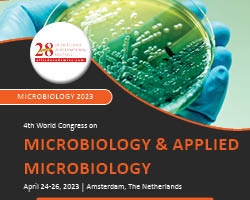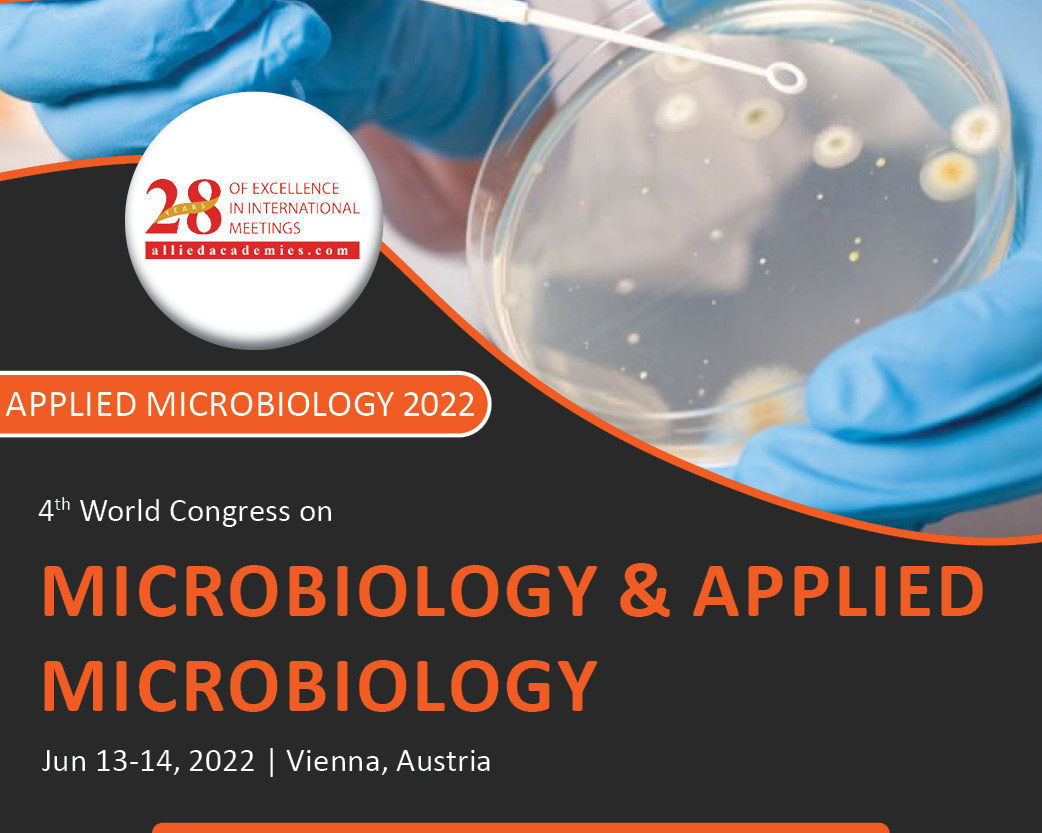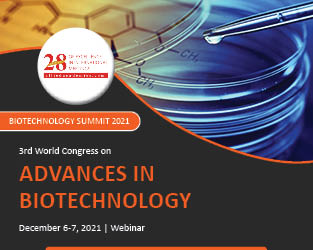2023 Conferences
2022 Conferences
2021 Conferences
2020 Conferences
With gratitude and pleasure, Allied Academies Conferences warmlywelcomes all to the MicrobiologyConferences.
With an extreme delight, we create a Global scientificplatform towards the betterment of future where all the professionals brought togetherunder a particular stand to discuss and share the advances and researches in Microbiology. Our objective is to bring organized minds to give talks thatare experience-focused which provoke discussions that matter.Microbiologyconferences have significantly made an impact on sharing many useful piecesof research to develop the disease-free human race.
Meet the Scientific Specialists and Speakersacross the globe at MicrobiologyConferences.
Microbiology is the study of microorganisms, sometimes known as microbes, which are a diverse group of microscopic basic life forms that include bacteria, archaea, algae, fungi, protozoa, and viruses. The structure, function, and classification of such creatures, as well as methods of exploiting and directing their activity, are all investigated in this topic.
Microorganisms are intricately linked to our daily lives. Microbes flourish in the earth, the seas, and the air, in addition to inhabiting both the inner and outside surfaces of the human body. Microorganisms are abundant, but often go unnoticed, and provide ample evidence of their presence—sometimes in a negative way, such as when they cause decay or spread diseases, and sometimes in a positive way, such as when they ferment sugar into wine and beer, cause bread to rise, flavour cheeses, and produce valuable products like antibiotics and insulin. Microorganisms are vital to Earth's ecology because they decompose animal and plant leftovers and convert them to simpler compounds that can be recycled by other organisms.
An Italian scholar, Girolamo Fracastoro, proposed in the mid-1500s that contagion is an infection that spreads from one item to another. Until the late 1800s, when the work of several scientists, including Pasteur, identified the role of bacteria in fermentation and disease, a description of exactly what is carried along remained elusive. A German physician named Robert Koch devised the technique for showing that a certain bacterium causes a specific disease (Koch's postulates).
Microorganisms come in a variety of shapes and sizes.
Bacteria, archaea, fungus (yeasts and moulds), algae, protozoa, and viruses are the major groups of microorganisms listed here. There are links to more thorough articles on each of the major groups.
Microbiology fundamentals:
Morphology:
The size, shape, and arrangement of cells is referred to as morphology. Microscopy of microbial cells necessitates not only the use of microscopes, but also the preparation of the cells in a way that is acceptable for the type of microscopy being used. The compound light microscope was the most widely used device in microbiology throughout the early decades of the twentieth century. The typical magnification factor of a light microscope is 1000, with a maximum usable magnification of around 2000. Specimens can be seen in living, unstained preparations as a "wet mount" or after they have been stained using one of various procedures to highlight some morphological traits.
Microscopy with electrons:
The invention of the electron microscope and other techniques significantly boosted the resolving power of light microscopy. Because electron beam wavelengths are so much shorter than light wavelengths, this increase is conceivable. In comparison to 0.25 m, electron microscopy can resolve objects as small as 0.02 nm, allowing for the detection of virions and viral architecture.
Physiological and nutritional characteristics:
Microorganisms as a whole have a wide range of nutritional requirements and environmental variables that will promote their growth. In this regard, no other group of living beings comes close to matching microorganisms' variety and diversity. Autotrophs are organisms that can thrive in a solution made entirely of inorganic salts (at least one of which must be a nitrogen molecule) and a source of carbon dioxide (CO2). Many of these bacteria, although not all, are phototrophic autotrophs. Heterotrophs are organisms that require another carbon source. Carbohydrates, lipids, and proteins are widely used by these microorganisms, while many may also metabolise other organic substances like hydrocarbons. Others, particularly fungi, degrade organic matter.
Reproduction and expansion:
Microbiology Conference | Microbiology Conferences | Food Microbiology Conference | Biotechnology Conference | Immunology Conference | Bacteriology Conference | Virology Conference | Environment Microbiology Conference | Pathogenicity Conference | Antibiotics Conference | Microbiology Events | Microbiology Meetings | Microbiology Gathering
Bacteria primarily reproduce through binary fission, an asexual process in which a single cell divides into two. In optimal conditions, some bacterial species can divide every 10–15 minutes, resulting in a population doubling every 10–15 minutes. Asexual and sexual mechanisms are used by eukaryotic bacteria to reproduce. To complete their life cycles, certain parasites require many hosts or carriers (vectors). Viruses, on the other hand, are created by the host cell they infect but are unable to reproduce themselves.
Metabolism:
Microorganisms have a surprising range of abilities when it comes to producing complex molecules from simple chemicals and decomposing complex things into simple chemicals. Nitrogen fixation—the creation of amino acids, proteins, and other organic nitrogen molecules from atmospheric nitrogen—is an example of their synthetic capabilities (N2). The only creatures capable performing this ecologically important process are bacteria and blue-green algae (cyanobacteria). White and brown rot fungus, which breakdown wood to simple molecules such as CO2, are an example of microorganisms' capacity to decompose complicated materials.
Pathogenesis:
Humans, other animals, and plants are all afflicted by germs. Pathogens are bacteria that cause disease. Pathogens are identified by the hosts they infect and the symptoms they produce; it's also important to figure out the pathogen's unique traits that contribute to its infectious capability, or virulence. The fewer pathogens need to establish an infection, the more virulent they are.
Features of antigenicity:
An antigen is a substance that induces the formation of certain substances (antibodies) that react or combine with the antigen when it is introduced into the body of an animal. Antigenic compounds are found in microbial cells and viruses. The specificity of antigen-antibody responses is important; antibodies produced by inoculating an animal with one microbe will not react with antibodies produced by inoculating the same animal with a different bacterium.
Characterization genetically:
Researchers have amassed a large quantity of data elucidating the chemical composition, production, and replication of the genetic material of cells since the final part of the twentieth century. Microorganisms have been used in a lot of this research, and procedures have been created that allow for molecular experimentation.
Microbiology in practise:
The topic of genetic engineering is one example of how basic and applied microbiology can collide. The field of genetic engineering is usually regarded as a branch of applied microbiology (that is, the exploitation of microorganisms for a specific product or use). The techniques utilised in genetic engineering were created through fundamental microbial genetics research.
Microbiology of the soil:
Regardless of how "dead" soil appears, it contains millions or billions of microbial cells per gramme, depending on soil fertility and environmental conditions. In or on soil, dead plants, human and animal wastes, and dead animals are deposited. They all decay over time into compounds that add to soil, and bacteria play a big role in this process.
Microbiology of food:
Microorganisms are important to foods for several reasons: (1) they can cause food spoiling, (2) they are employed to make a wide range of food items, and (3) they can transmit microbial diseases.
Preservation of food:
All food preservation techniques are founded on one or more of the following principles: (1) contamination and removal of microorganisms, (2) microbial growth and metabolism suppression, and (3) microorganism killing The sanitary handling of raw food products, the inhibition of growth by low temperatures (refrigeration or freezing), dehydration by evaporation or high concentrations of salt or sugar, and the killing of microbes by the application of high temperatures and, in some cases, radiation all contribute to the prevention—or, more accurately, minimization—of contamination.
Products derived from microbes in food:
Pickles, sauerkraut, olives, soy sauce, certain types of sausage, all unprocessed cheeses except cream cheese, and many fermented milk products such as yoghurt and acidophilus milk are examples of foods generated in whole or in part by the biochemical activity of microorganisms.
Microbiology in industry and genetic engineering:
Microbial metabolism produces a wide range of chemicals with significant economic significance. The substrate can be thought of as a raw material, and the microbe as a "chemical factory" for transforming the raw material into new products from an industrial standpoint. If an organism can be shown to transform a cheap raw material into a useful product, the reaction could be replicated on a big industrial scale if the following conditions are met.
Pathology of plants:
Plants are infected by thousands of different species of organisms, the majority of which are bacteria. Viruses, bacteria, mycoplasma-like organisms, and fungus are among the disease-producing plant pathogens that cause considerable agricultural losses. Plant pathology is the study of plant diseases.
Current Research Trends in Microbiology:
Establishment of CRFK cells for vaccine production by inactivating endogenous retrovirus with TALEN technology
ABO genotype alters the gut microbiota by regulating GalNAc levels in pigs
Anti-tuberculosis treatment strategies and drug development: challenges and priorities
Chromosome-encoded IpaH ubiquitin ligases indicate non-human enteroinvasive Escherichia
Mutational meltdown of putative microbial altruists in Streptomyces coelicolor colonies
Mechanisms of fungal community assembly in wild stoneflies moderated by host characteristics and local environment
Market Analysis:
Statistical surveying exams are comprehensive of key facts and data concerning the Global Microbiology market values by district forecast to 2028, with the corresponding data expected to grow at a compound annual growth rate of 8.63 percent throughout the forecast period. The rapid growth noticed in the mature population in the field of Clinical Microbiology by an increasing number of clinical scientists drives the microbial science testing company sector to recognise clinically significant microorganisms, which is propelling the trade forward. These factors fuel the growth of the Microbiology testing industry and increase the frequency of irritating illnesses, resulting in a flare-up of pandemics, such as COVID 19. As the economy grows, new opportunities for the Microbiology testing market emerge. Clinical preliminaries and an increasing quantity of administrations greatly influence the market's interest. Market testing in the present and future explores numerous market criteria in the turn of events and expanding company sectors.
According to an article published in the journal of clinical organic science, microbiological labs lack prepared and capable professionals for handling and deciphering tests and examples. In non-industrial countries, a lack of qualified graduates and training programmed is a major problem. Interest in skilled specialists is growing quickly everywhere. However, from now on, a greater proportion of machine-driven frameworks in the market will swap physically worked routinely stages, reducing the impact of the lack of skilled experts.
The applied microbial science market was valued at over USD 24.3 billion in 2017 and is expected to grow at a 7.9% CAGR from 2017 to 2024, exceeding the USD 675.2 billion market. At Global Market Insights, it's a one-of-a-kind mix of essential and optional exams, with approval and changes, to limit differences and provide the most dependable business investigation.
Top Societies and Associations in Microbiology:
Microbiology Conference | Microbiology Conferences | Food Microbiology Conference | Biotechnology Conference | Immunology Conference | Bacteriology Conference | Virology Conference | Environment Microbiology Conference | Pathogenicity Conference | Antibiotics Conference | Microbiology Events | Microbiology Meetings | Microbiology Gathering
American Society for Microbiology
Federation of European Microbiological Societies
Society for Applied Microbiology
Society for General Microbiology
Australian Society for Microbiology
International Union of Microbiological Societies
The Canadian Society of Microbiologists
UCC Microbiology Society
Society for Industrial Microbiology and Biotechnology
Top Colleagues or Universities:
University of California
Washington University
University of Pennsylvania
Stanford University
University of Cambridge
University of Edinburgh
Imperial College London
University of Toronto





